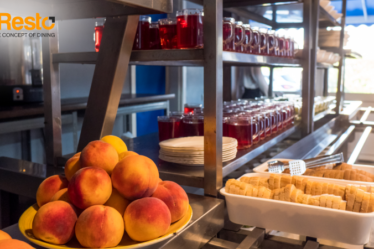
It must have hurt you when your restaurant’s ‘Star Employee’ or staff member(s) resigned. All your efforts to keep them went in vain. And you must be wondering where things go south. To know this, answer these questions –
- Did you take feedback from them?
- Did you pay them fairly?
- Were they prepared to handle the growth of your restaurant?
Well, these are not the only reasons why employee turnover in restaurants is increasing. After reading this piece, you’ll have clarity on the possible reasons for their ‘goodbyes.’ However, the more you scroll below, the more tips you’ll get to reduce employee turnover in restaurants. But first, let’s begin with the ‘employee turnover.’
Understanding the Employee Turnover in Restaurants
Employee turnover in restaurants means figuring out why employees leave their jobs. The reason could be anything – less pay, more work hours, or even the environment. Mostly, the reason is they found another job.
How to Calculate Employee Turnover in Restaurants?
Want to calculate your restaurant’s turnover rate? Then just follow these simple steps –
- Find out how many people quit or were fired during a certain time (like a month or year).
- Now add the number of employees at the beginning of the period to the number at the end. Then, divide that total by 2 to get the average number of employees during that time.
- Apply this formula –
Turnover Rate= (Average Number of Employees / Employees Who Left)×100
For example, if 10 people left in a year and you had an average of 50 employees:
Turnover Rate= (50/ 10)×100=20%
This means 20% of your employees left during the year.
Employees Turnover – Reasons for this Sour Taste
- Long Work Hours
Spending more hours than usual work hours in the restaurant is the reason for the high turnover. During festive or holiday seasons or due to many other events, staff must work 10 or 12 hours a day with limited breaks.
And often, regular days are too long. Making the staff feel super tired and stressed out. Over time, they can get burned out, which means they no longer feel excited or motivated to work.
Long hours can also mess with their personal lives, meaning less time for family and relaxation. When employees feel exhausted, they might quit their jobs or look for places with shorter hours.
- Pay Doesn’t Match the Effort
A lot of jobs in the industry don’t pay well, and this is a big problem. When employees don’t get what they deserve and as per their working hours, they choose to leave their jobs.
Though, it’s not how much they make. Other things like – health insurance, dental and vision coverage, and retirement plans also matter. If staff don’t get good benefits, they’re more likely to quit and look for a job where they feel better cared for.
- Unclear Communication
When managers or coworkers don’t explain things clearly, it can cause communication gaps in the kitchen and mistakes. If employees don’t understand
- what they need to do,
- when they have to work or
- what’s expected of them.
It can make their job stressful and upsetting. If a manager doesn’t explain changes to the menu or give clear instructions, workers might not do their job right. This can make them feel like they aren’t supported or important.
- Rigid Schedules
The problem with not having flexibility in restaurant jobs is that it can cause stress. While some people dislike not having a set schedule, many workers don’t like not knowing when they will each week. Managing personal things like family or school is hard if they can’t plan their hours.
If their schedules are presented to them at the last minute, they may feel their time is not valued. This can make employees unhappy and more likely to quit for a position with a more regular schedule.
- Uncertain Future
Employees leave their restaurant jobs for many reasons – no scope for growth opportunities. Many employees, mainly young ones, think it’s a dead-end job.
If they feel like their bosses only see them as temporary staff or replaceable, they won’t stay. They want chances to improve and get promoted. They’re more likely to quit if not given development opportunities.
- Rising Cost of Living
Some team members struggle to make ends meet as food, rent, and gas prices rise. If their paycheck is unable to cover their expenses, they might start looking for high-paying jobs. Additionally, employees facing financial stress may feel undervalued, leading to frustration and decreased job satisfaction. This can result in higher turnover rates as they seek better-paying opportunities elsewhere.
Reduce Employee Turnover in Restaurants: A Secret Recipe
Curious to know how to reduce employee turnover in restaurants? Here’s the list of steps, take these and create the perfect recipe for restaurant staff retention –
- Prepare them for Success
When you get the first steps right, like good training and onboarding, employees are more likely to stay at your restaurant. Great training can make a huge difference in a new employee’s success.
Every restaurant is different, so it’s important to teach new employee(s) about –
- the menu,
- the customers,
- the technology you use,
- promotions you run, and everything else, like how your restaurant works.
This helps them feel ready to do their job and shows that you care about their success.
Employees who feel confident and supported are more loyal and less likely to leave. Ongoing training also helps, like teaching them food preparation, or customer services. This keeps employees happy, improves work, and helps your restaurant run effectively.
- Fair Pay, Happy Team
Want to know the secret ingredient for retaining staff in restaurants? It’s fair and competitive pay. If workers feel paid enough to cover their needs, like rent and food, they’re more likely to stay.
Besides good starting pay, it’s also a great idea to give raises or rewards to employees doing well. Regular reviews show your employees that you appreciate their work. Even the small raises make a big difference in keeping your employees happy.
| Tip – Ensure that you offer a good wage compared to other restaurants in your area. |
- Recognize Efforts
It’s easy to forget to appreciate employees in a busy restaurant, but a simple ‘good job’ means a lot. Hard-working employees want to feel valued; when they do, they will most likely stay.
One way to show appreciation is by giving awards like “Employee of the Month” with gift cards, extra time off, or free meals. Some restaurants also offer bonuses for great work, like meeting sales or customer service goals. Recognizing employees for their efforts makes them feel meaningful and motivated.
- Safety First, Always
The next step that will reduce employee turnover in restaurants is a sense of safety. Staff can get hurt by cuts, burns, slippery floors, stress, or exhaustion. That’s why keeping a safe workplace is so important. It’s the responsibility of restaurant owners to train employees and teach them about kitchen tools and cleaning products safely. Follow these safety and staff retention tips for restaurants –
- Provide your employees with safety gear like gloves and slip-resistant shoes.
- Security measures like cameras and key-card entry can help protect staff.
- Regular maintenance and safety checks help everything work perfectly.
When employees feel safe in the restaurant, they’re happier and work harder. A safe workplace makes them want to stay longer!
- Smart Work With Technology
Using the right technology like restaurant management software, can make restaurant jobs more manageable and less stressful. A modern POS system helps orders move quickly from the kitchen to servers to customers, improving workflow.
- Faster table management reduces long wait times.
- Self-service options, like online ordering and kiosks, take pressure off staff by allowing customers to place their orders.
- Inventory management software ensures supplies never run low.
- Use scheduling apps to organize shifts and communicate with teams.
Such integration of technology will result in reducing restaurant turnover. Operations will be easier to manage and work run efficiently, making employees happy, productive, and less likely to leave.
- Help them Grow
Many restaurant staff members have started by washing dishes or taking orders; however, they don’t want to stay in that role forever. Training, mentorship, or chances to grow are noteworthy restaurant employee retention plans.
- Training Program –
Teach them essential skills like leadership, customer service, and teamwork.
- Cross-training –
Let employees learn different jobs – from fine-dining skills to cooking, beverage preparation, inventory management, using a POS system, and running a restaurant successfully.
Don’t think you are wasting money teaching your employees, but you’re investing in your and your restaurant’s future.
- Learn from Goodbyes
Sometimes, employees leave no matter how hard you have tried. Well, you must be curious ‘why it’s happening?’ So, the best way is to conduct an ‘exit interview.’
This process aims to identify the reason and solve it as soon as possible. Let’s say if many employees mention problems with the same manager and talk to the manager about improving their relationships with the team. This helps improve the workplace and reduce future turnover.
The Final Batter
To reduce employee turnover in restaurants – sufficient pay or a good environment is the key. They want to be seen, supported, and motivated. By giving good training, ensuring a safe workplace, offering growth chances, and rewarding hard work, you can make your restaurant a place people want to stay. Using technology can help make their jobs easier too. When workers feel valued and have the right tools, they’ll stay longer and help your restaurant do well. Keep listening to their ideas and always try to improve!


